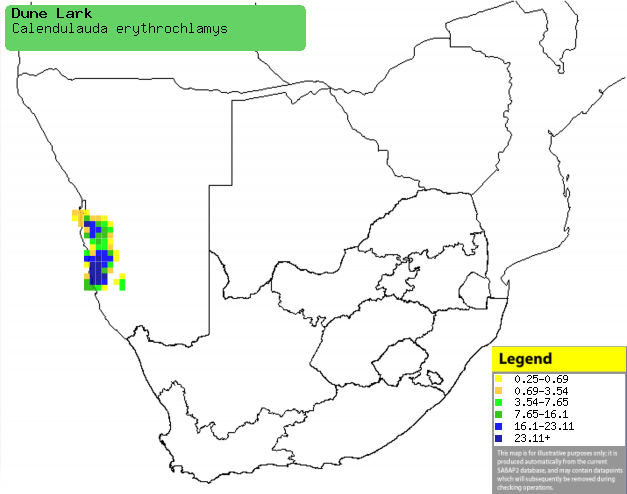|
Calendulauda erythrochlamys (Dune lark)
[= Mirafra erythrochlamys]
Duinlewerik [Afrikaans]; Alouette à dos roux [French]; Dünenlerche
[German]; Cotovia-das-dunas [Portuguese]
Life
> Eukaryotes >
Opisthokonta
> Metazoa (animals) >
Bilateria >
Deuterostomia > Chordata >
Craniata > Vertebrata (vertebrates) > Gnathostomata (jawed
vertebrates) > Teleostomi (teleost fish) > Osteichthyes (bony fish) > Class:
Sarcopterygii (lobe-finned
fish) > Stegocephalia (terrestrial
vertebrates) > Tetrapoda
(four-legged vertebrates) > Reptiliomorpha > Amniota >
Reptilia (reptiles) >
Romeriida > Diapsida > Archosauromorpha > Archosauria >
Dinosauria
(dinosaurs) > Saurischia > Theropoda (bipedal predatory dinosaurs) >
Coelurosauria > Maniraptora >
Aves (birds) > Order:
Passeriformes
> Family:
Alaudidae
> Genus:
Calendulauda
Distribution and habitat
Endemic to Namibia's Namib Desert, preferring sparsely
vegetated dunes punctuated with shrubs and grasses such as Namib dune bushman
grass (Stipagrostis salbulicola) and ¡Nara melons (Aconthosicyos
horridus).
|
 |
|
Distribution of Dune lark in southern Africa,
based on statistical smoothing of the records from first SA Bird Atlas
Project (©
Animal Demography unit, University of
Cape Town; smoothing by Birgit Erni and Francesca Little). Colours range
from dark blue (most common) through to yellow (least common). |
Food
It eats a variety of insects and seeds, exposing
sand-covered food items by digging with its bill, and catching prey aerially or
gleaning from the leaves and bases of grasses. The following food items have been recorded
in its diet:
- Invertebrates
- Seeds
- Amaranthus (pigweed)
- Hermannia
- Limeum phenostratima (Klosaarbossie)
- Trianthema hereroensis
- Giseckia (volstruisduiwe)
- Brachiara glomerata (signal grass)
- Stipagrostis ciliata (Tall bushman grass)
Breeding
- The nest is built solely by the female in 7-9 days, consisting of a domed
cup built of coarse grass and lined with finer plant material, feathers,
hair and reptile skin, often secured together with the webs of burrowing
spiders. It is typically placed in a depression dug into sand at the
base of a shrub or grass tuft, usually facing south-east to maximise shade
during the day.
- Egg-laying season is year-round, as it opportunistically lays its eggs
after rain.
- It lays 1-2 eggs, which are incubated solely by the female for about
13-14 days.
- The chicks are brooded by the female for the first 4 days, with both
parents feeding invertebrates to the chicks during the roughly 12-14 day
long nestling period. They leave before before being able to fly, hiding and
skulking in vegetation.
Threats
Not threatened, as almost its entire population is within
the boundaries of the Namib-Naukluft National Park.
References
-
Hockey PAR, Dean WRJ and Ryan PG 2005. Roberts
- Birds of southern Africa, VIIth ed. The Trustees of the John Voelcker
Bird Book Fund, Cape Town.
-
Harrison, J.A., Allan, D.G., Underhill, L.G., Herremans, M.,
Tree. A.J., Parker, V. & Brown, C.J. (eds). 1997. The atlas of southern
African birds. Vol. 2: Passerines. BirdLife South Africa, Johannesburg.
|
